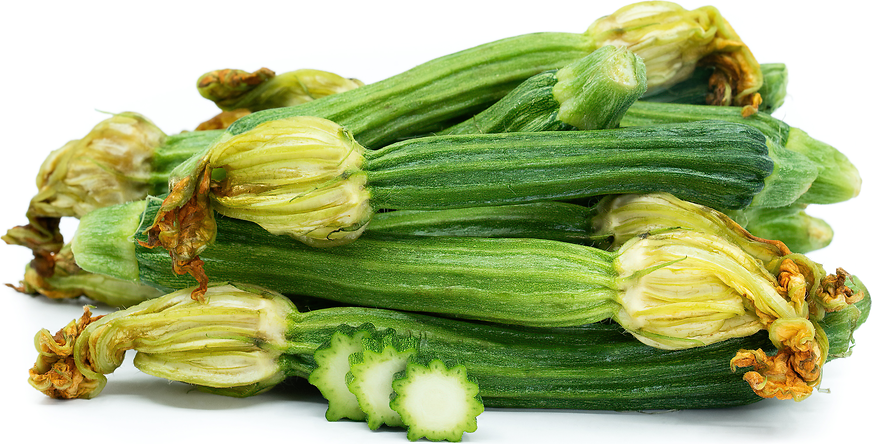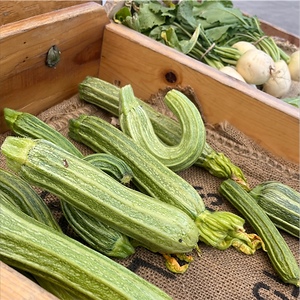


Baby Romanesco Costata Squash with Flower
Estimated Inventory, lb : 0
Description/Taste
Baby Romanesco Costata squash is small in size, averaging 12 to 17 centimeters in length and 1 to 2.5 centimeters in diameter, and has a straight to slightly curved, elongated, cylindrical, and slender shape. The squashes are harvested young, and if left to mature on the plant, they can grow upwards of 30 to 40 centimeters in length and 7 to 10 centimeters in diameter, sometimes larger. Baby Romanesco Costata squash is distinguished from other varieties for its textured, ridged surface. The exterior is covered with 8 to 10 prominent ribs extending the length of the zucchini, forming small grooves on the surface. The skin also showcases variegated green-grey, pale green to dark green hues, creating a striped and speckled appearance, and small hairs cover the surface. Baby Romanesco Costata squashes are commonly seen with their pale orange-yellow flowers still attached when young. These flowers are soft, delicate, and fleeting, only staying fresh for a few hours to days. Underneath the surface of the squash, the pale green to white flesh is dense, firm, and crisp with a lightly aqueous consistency. When sliced, the flesh has a decorative, star-like shape and is characteristically firmer, less spongy, and less watery than other squash varieties. Baby Romanesco Costata squash is edible raw, and the skin, flesh, and flowers can be eaten fresh, producing zero waste. The squashes release a faint, vegetal, and fresh aroma and have a sweet, neutral, green, and subtly nutty taste. The flowers have a mild, vegetal, and faint flavor reminiscent of the squash.
Seasons/Availability
Baby Romanesco Costata squash is typically available from the late winter through fall and is grown in open fields and greenhouses. Mature Romanesco Costata squash has a peak season in the spring through summer.
Current Facts
Baby Romanesco Costata squash, botanically classified as Cucurbita pepo, is an Italian heirloom variety belonging to the Cucurbitaceae family. Within the species, Romanesco Costata is part of a subspecies known as cocozelle squash and is considered a popular summer squash for commercial cultivation and home gardening in Italy. The squashes are botanically a fruit but are generally utilized in savory preparations using vegetable cooking methods. Baby Romanesco Costata squashes grow on upright, bushy plants, and the squashes mature approximately 52 days after pollination. The variety is a low-producing plant, generating fewer squashes than other cultivars per growing season, but the variety is revered for its stronger flavor and improved texture. Baby Romanesco Costata squashes are generally hand-harvested, and the young squashes are sold individually or with flowers still attached. Flowers attached to the squashes are the female versions, and flowers growing from a stem without the squashes are labeled male flowers. Baby Romanesco Costata squashes with flowers are a seasonal symbol of Rome and are a symbol of freshness in markets. The flowers only last a few hours to days, so vendors must sell the squashes quickly to consumers. Chefs and home cooks also know this fleeting nature and use the flowers to indicate the squash’s freshness. The name Romanesco Costata translates from Italian to mean “Ribbed Roman” squash, and the young squashes are labeled a zero-waste product as the entire squash and flower can be eaten raw or cooked. Baby Romanesco Costata squashes are also known as Costata Romanesca, Roman Costata, Courgette of Lazio, Ribbed squash, and Roman Ribbed squash, and are utilized in a wide array of raw or cooked culinary applications throughout the Lazio region of Italy.
Nutritional Value
Baby Romanesco Costata squash is a source of fiber to regulate the digestive tract, potassium to balance fluid levels within the body, and vitamin E to protect the cells against damage caused by free radicals. The squashes also provide vitamin A to maintain healthy organs, manganese to develop connective tissues, and other nutrients, including riboflavin, folate, and vitamin B6. Summer squashes, in general, are viewed as a natural diuretic for their water content and are consumed for their anti-inflammatory properties.
Applications
Baby Romanesco Costata squash with flowers has a mild, sweet, and nutty taste suited for fresh and cooked preparations. The squashes can be washed to remove the small hairs and consumed raw in salads and appetizer platters. The squashes can also be shaved into ribbons for pasta, grated for coleslaws, or used as a base ingredient for soups and bread. In Rome, it is not common for Romanesco Costata squashes to be eaten raw. They are traditionally cooked or lightly sauteed before serving. The variety’s denser nature allows it to hold its shape in heated applications, and it is a preferred squash for grilling, roasting, sautéing, baking, and steaming. Baby Romanesco Costata squashes are grilled into patties and layered into sandwiches with pesto, pecorino, or parmesan or used as a pizza topping. The squashes are also popularly battered and fried, shredded into fritters, sliced thin and baked into chips, or fried and marinated as a side dish. Larger Romanesco Costata squashes can be hollowed, stuffed with a mixture of parsley, garlic, eggs, and parmesan, and then stewed in a tomato and onion base as a savory main dish. The squashes can also be chopped into soups such as minestrone, cooked and tossed into pasta and risotto, or roasted and sprinkled with lemon juice, cheese, nuts, and fresh herbs. In Rome, it is common to see the variety incorporated into various sandwiches, used as a bruschetta ingredient, or baked on top of fresh focaccia. Beyond the squashes, the flowers are stuffed, fried, sauteed, or cooked into omelets, soups, and pastas. Baby Romanesco Costata pairs well with tomatoes, eggplant, olives, aromatics such as garlic, onions, and shallots, herbs including thyme, basil, mint, and oregano, and cheeses such as mozzarella, feta, ricotta, and pecorino romano. Whole, unwashed Baby Romanesco Costata will keep up to one week when stored in a ventilated container in the refrigerator’s crisper drawer. The flowers have a shorter shelf life and should be immediately consumed for the best quality and flavor.
Ethnic/Cultural Info
Romanesco Costata flowers are famously fried and served as an appetizer or street food in Rome. The popularity of the fried flower was said to have been birthed by everyday recipes created by a Roman Jewish community. For several centuries, communities of Jewish residents lived in relative isolation in walled-in areas of Rome known as the Jewish Quarter or the Roman Ghetto. During this time, the community developed a distinct cooking style called cucina ebraica, which involved frying fresh vegetables such as squash flowers and artichokes. Over time, fried squash flowers spread in popularity throughout Rome, and the flowers were stuffed with anchovies and mozzarella before they were coated in a batter and fried. This combination created a stringy, gooey, and melting interior, contrasting the crisp, crunchy, and puffy exterior. Fried squash flowers have remained a favored finger food throughout Rome, and the flowers are a seasonal delicacy prepared through vendors, at home, and in restaurants.
Geography/History
Squashes belonging to the species Cucurbita pepo are descendants of wild species with origins in Central and South America. These wild species were domesticated over time by indigenous populations, and Spanish explorers carried seeds of the ancient species to Europe sometime around the 16th century. After its European introduction, Cucurbita pepo species were widely planted throughout Italy in the 16th century and were selectively bred in the 19th century in gardens near Milan. Various cultivars were later transported south to Rome and were naturally bred over time to produce improved characteristics. It is unknown when Romanesco Costata squashes were created, but the variety was thought to have been mentioned in Murattian Statistics, a recorded work dating to 1811. The striped cultivar eventually expanded in cultivation throughout Lazio, the region encompassing the city and province of Rome. In the 20th century, Romanesco Costata squash was carried to the United States with Italian immigrants and became a popular home garden cultivar. Today, Romanesco Costata squashes are primarily sold in commercial markets throughout Rome and are grown in the municipalities of Ladispoli, Cerveteri, Terracina, Formia, Maccarese, and Sperlonga. The variety is also found on a smaller scale throughout fresh markets in other regions of Italy. Outside of Europe, Romanesco Costata squash is mainly produced as a home garden crop, occasionally offered through farmers' markets, and selected distributors as a seasonal squash. The Baby Romanesco Costata squashes featured in the photograph above were sourced through Mercato Trionfale in Rome, Italy.








